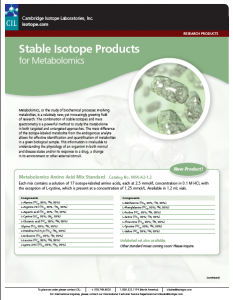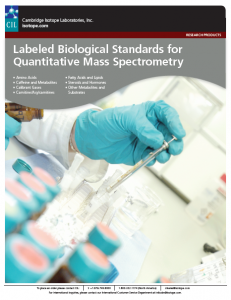
Metabolomics, or the study of biochemical processes involving metabolites, is a relatively new, yet increasingly growing field of  research. The use of stable isotopes as internal standards, combined with mass spectrometry in metabolomics, allows researchers to identify and quantify metabolites in a given biological sample. This information is invaluable to understanding the physiology of an organism and/or its response to a drug, a change in its environment, or other external stimuli.
research. The use of stable isotopes as internal standards, combined with mass spectrometry in metabolomics, allows researchers to identify and quantify metabolites in a given biological sample. This information is invaluable to understanding the physiology of an organism and/or its response to a drug, a change in its environment, or other external stimuli.
 |
Stable Isotope Products for Metabolomics – Product Listing |
 |
Metabolomic QC Kit Technical Information Sheet |
 |
Labeled Biological Standards for Quantitative Mass Spectrometry |
Metabolomic QC Kit (MSK-QC-Kit)
for untargeted and targeted MS-based metabolomic applications
Quality control (QC) of methods and processes is an essential factor toward the generation of reliable mass spectrometry (MS) data. In order to obtain accurate and precise metabolomic data that can be reproduced by independent laboratories around the world using different MS technologies, standardised protocols and reagents are necessary.
Kit Features and Benefits:
| Enables analytical precision to be determined | Allows metabolite quantitation |
| Identifies performance deficits | Pinpoints method-specific issues |
| Diminishes interlaboratory variability | Improves method transferability |
Frequently Asked Questions
Why are stable isotopes useful in metabolomics?
- When used in conjunction with mass spectrometry, stable isotopes allow for quantitation and identification of metabolites in order to give an overview of the cellular fate of metabolites. Stable isotopes can be used for metabolite profiling and to look at metabolic flux.
Which products are typically used for metabolomics?
- Researchers can use a variety of labeled metabolites including amino acids, carbohydrates, fatty acids & lipids, etc. Those performing flux analysis, looking at cancer metabolism for example, often use D-Glucose (U-13C6, 99%) (CLM-1396) and L-Glutamine (13C5, 99%) (CLM-1822-H).
One of the bottlenecks with metabolomics is metabolite identification. Are there databases available to the public that allow for metabolite ID?
- Yes, there are a few different options. METLIN is a current and comprehensive repository for such metabolites. It includes structures and tandem mass spectrometry data, as well as other pertinent information for metabolite ID. (http://metlin.scripps.edu/index.php).
The metabolomic processing software associated with METLIN is called XCMS and is available online (http://metlin.scripps.edu/xcms/). It is designed to read and process LC/MS data to assist with metabolite profiling by identifying changes in endogenous metabolites.
What algal strain is used to create Mixed Triglycerides products?
- Agmenelum quadriplicatum
What algal strain is used to create Mixed Fatty Acids products?
- Agmenelum quadriplicatum
What algal strain is used to create the Amino Acid Mixes product?
- Agmenelum quadriplicatum
What algal strain is the Whole Algal Cells product?
- Agmenelum quadriplicatum
Application Notes
A collection of helpful specific articles written by our customers which may be of use to you….and are just generally interesting reads anyway.
- Cellular Metabolism and Metabolomics
- Analysis of Whole-Body Branched-Chain Amino Acid Metabolism in Mice Utilising 20% Leucine 13C6 and 20% Valine 13C5 Mouse Feed (Application Note 43)
- Fluxing Through Cancer: Tracking the Fate of 13C-Labeled Energy Sources Glucose and Glutamine in Cancer Cells and Mouse Tumors (Application Note 34)
- Procedures for Large-scale Metabolic Profiling of Serum and Plasma Using GC and LC Coupled to Mass Spec (Please note this links out to NCBI)
- Profiling of Polar Organic Acids in Mouse Muscle Using Ion Chromatography/Mass Spectrometry
- Pathway-Targeted Metabolomic Analysis in Oral-Head and Neck Cancer Cells Using IC-MS (Application Note 44)
- New Reactive Organic Reagents for Footprinting Proteins
Metabolomics
Product Search
Got a Question?
For information please start your enquiry below:
